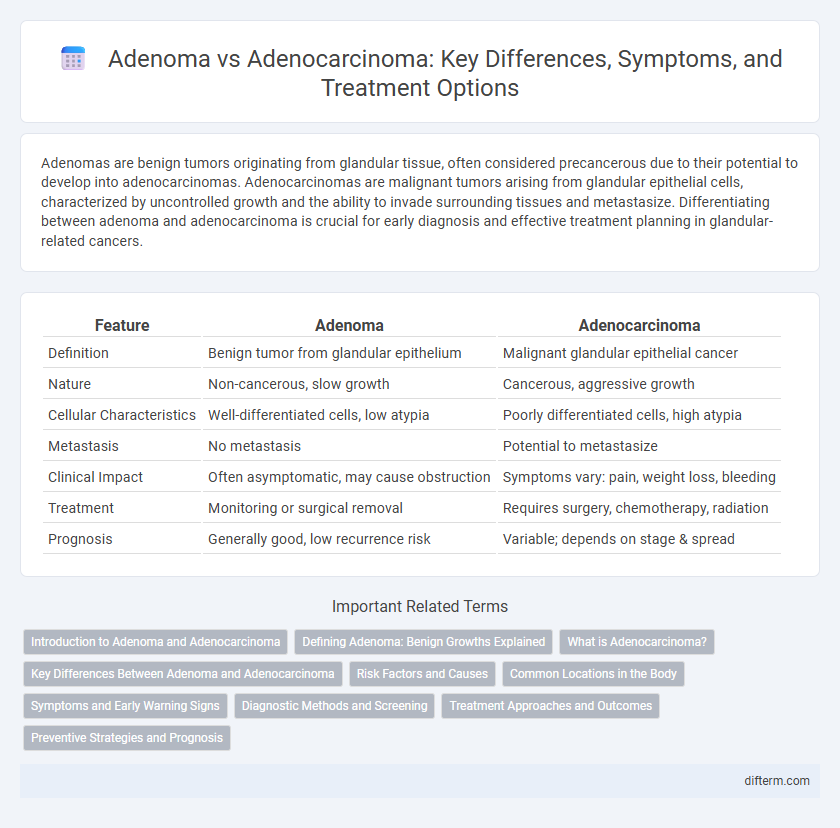Adenomas are benign tumors originating from glandular tissue, often considered precancerous due to their potential to develop into adenocarcinomas. Adenocarcinomas are malignant tumors arising from glandular epithelial cells, characterized by uncontrolled growth and the ability to invade surrounding tissues and metastasize. Differentiating between adenoma and adenocarcinoma is crucial for early diagnosis and effective treatment planning in glandular-related cancers.
Table of Comparison
| Feature | Adenoma | Adenocarcinoma |
|---|---|---|
| Definition | Benign tumor from glandular epithelium | Malignant glandular epithelial cancer |
| Nature | Non-cancerous, slow growth | Cancerous, aggressive growth |
| Cellular Characteristics | Well-differentiated cells, low atypia | Poorly differentiated cells, high atypia |
| Metastasis | No metastasis | Potential to metastasize |
| Clinical Impact | Often asymptomatic, may cause obstruction | Symptoms vary: pain, weight loss, bleeding |
| Treatment | Monitoring or surgical removal | Requires surgery, chemotherapy, radiation |
| Prognosis | Generally good, low recurrence risk | Variable; depends on stage & spread |
Introduction to Adenoma and Adenocarcinoma
Adenomas are benign tumors originating from glandular epithelial tissue, often characterized by slow growth and limited invasion. Adenocarcinomas, in contrast, are malignant tumors arising from the same glandular epithelium but exhibit aggressive behavior, including local invasion and potential metastasis. Understanding the cellular origin and biological behavior of adenoma versus adenocarcinoma is crucial for accurate diagnosis and effective treatment planning.
Defining Adenoma: Benign Growths Explained
Adenoma refers to a benign tumor originating from glandular epithelial tissue, characterized by localized growth without invasive properties. These noncancerous adenomas typically remain confined and lack the potential to metastasize, differentiating them from malignant counterparts. Understanding adenomas is crucial for early detection and prevention of progression to adenocarcinoma, a malignant glandular cancer.
What is Adenocarcinoma?
Adenocarcinoma is a type of malignant tumor originating from glandular epithelial cells that line organs such as the lungs, colon, pancreas, and prostate. It is characterized by uncontrolled cell growth, invasion of surrounding tissues, and potential metastasis, distinguishing it from benign adenomas. Early detection and histopathological analysis are critical for effective treatment and improved patient outcomes.
Key Differences Between Adenoma and Adenocarcinoma
Adenoma is a benign tumor originating from glandular epithelial tissue, characterized by slow growth and lack of invasive properties. Adenocarcinoma is a malignant tumor arising from glandular epithelium with aggressive behavior, potential for metastasis, and cellular atypia. Key differences include adenoma's non-invasive nature versus adenocarcinoma's invasiveness, degree of cellular differentiation, and potential to disrupt normal tissue function.
Risk Factors and Causes
Adenomas, benign tumors arising from glandular tissue, primarily develop due to genetic mutations, chronic inflammation, and hormonal imbalances, with risk factors such as age, family history, and exposure to carcinogens contributing to their formation. Adenocarcinomas, malignant glandular tumors, often result from the malignant transformation of adenomas driven by accumulated DNA damage, environmental factors like smoking and diet, and conditions such as Barrett's esophagus or chronic pancreatitis. Both tumor types share underlying molecular pathways, including mutations in oncogenes like KRAS and tumor suppressor genes like TP53, which are critical in the progression from benign adenoma to invasive adenocarcinoma.
Common Locations in the Body
Adenomas commonly develop in the colon, thyroid, adrenal glands, and pituitary gland as benign tumors with potential to progress. Adenocarcinomas primarily arise in glandular tissues of the lung, pancreas, prostate, breast, and gastrointestinal tract, representing malignant growths. Identifying the lesion location is crucial for determining treatment strategies and prognostic outcomes in neoplastic conditions.
Symptoms and Early Warning Signs
Adenomas typically present with minimal or no symptoms and are often detected during routine screenings or imaging studies, whereas adenocarcinomas frequently cause noticeable symptoms such as unexplained weight loss, persistent pain, or changes in organ function. Early warning signs of adenocarcinoma may include abnormal bleeding, a palpable mass, or organ-specific dysfunction, emphasizing the importance of timely medical evaluation. Differentiating these conditions through symptom assessment and diagnostic tests is critical for appropriate treatment planning.
Diagnostic Methods and Screening
Diagnostic methods for differentiating adenoma from adenocarcinoma primarily include histopathological examination through biopsy and imaging techniques such as endoscopic ultrasound and MRI. Screening protocols emphasize colonoscopy and targeted tissue sampling to identify adenomatous polyps before malignant transformation into adenocarcinoma occurs. Molecular markers and immunohistochemistry further assist in confirming malignancy and guiding appropriate clinical management.
Treatment Approaches and Outcomes
Treatment approaches for adenomas typically involve surgical removal or endoscopic resection, with a high success rate and minimal risk of recurrence due to their benign nature. Adenocarcinoma requires more aggressive interventions, including surgery, chemotherapy, and radiation therapy, depending on the stage and location of the tumor, often resulting in variable outcomes based on early detection and response to treatment. Prognosis for adenomas is generally excellent, whereas adenocarcinoma outcomes depend heavily on tumor staging, with lower survival rates in advanced cases.
Preventive Strategies and Prognosis
Preventive strategies for adenoma primarily involve regular screenings such as colonoscopies to detect and remove polyps before malignant transformation, along with lifestyle modifications including a diet high in fiber and low in red meat. Adenocarcinoma prognosis varies significantly based on stage at diagnosis, with localized tumors showing higher survival rates, while advanced cancer requires multimodal treatments including surgery, chemotherapy, and radiotherapy. Early detection through routine surveillance remains crucial in improving outcomes and reducing the progression from benign adenoma to malignant adenocarcinoma.
Adenoma vs Adenocarcinoma Infographic

 difterm.com
difterm.com